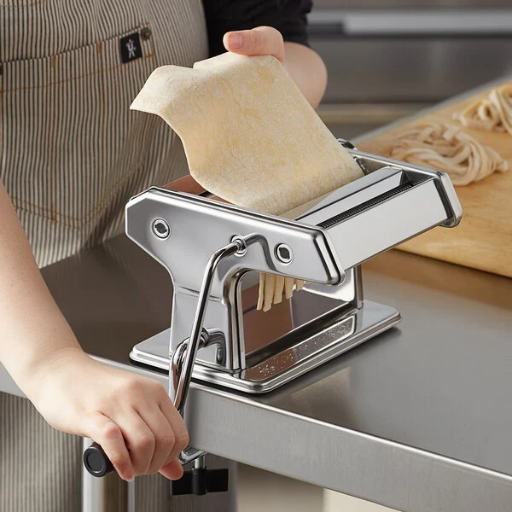Most people who love food want to be good at making fresh pasta at home. It is advisable to start with getting the correct tools to help you in this process, which will eventually become an exciting journey. This guide provides a step-by-step procedure for identifying the top hand-crank pasta maker in 2024. We have handled everything you need, from checking the quality, make, and ease of use to other functions and price brackets. From entry-level cooks to those already experts at making pasta, our analysis has been designed to assist in your selection so that you don’t have a hard time when it comes to rolling out excellent homemade paste each time.
How Does a Pasta Maker Work?
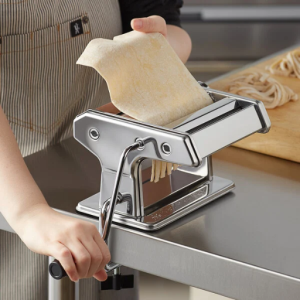
Image source: https://www.webstaurantstore.com/
The hand-crank pasta maker functions using rollers and cutters. Firstly, the dough for your pasta is prepared and slightly flattened using the hands. Afterward, you pass the dough into the machine’s rollers, adjusting the width to suit your requirements. As you now rotate a handle on a side, it will cause rolling pins to crush or flatten out one’s pastry into narrow sheets. The next step is passing this sheet through a cutter attachment to derive diverse forms like spaghetti or tagliatelle. The manual procedure enables you to control how thick or soft your pasta turns out, yielding results that are consistently good.
Understanding the Roller and Cutter Mechanism
Knowing the roller and cutter mechanism is essential to choosing a pasta maker that works by hand. The roller is used for mixing and stretching pasta dough, enabling it to have different thicknesses ranging from wafer-thin sheets to thick layers for stuffed pasta. With adjustable roller settings on good-quality machines, you can precisely control its thickness.
The shape of the pasta is made by the cutter mechanism, which is usually interchangeable. Usually available are spaghetti, fettuccine, and other things that can be fitted into some models, such as lasagne or ravioli. The key to getting smooth and effective operations is how well aligned and built cutters and rollers are, which ensure uniform pressure and output throughout the process, enhancing your homemade pasta quality. This makes making your pasta at home more exciting and satisfying.
How to Use a Manual Pasta Maker Efficiently
A manual pasta maker is an efficient way to go about it if you want to prepare dough properly. It should be well-kneaded, smooth, and slightly elastic before feeding into the machine. To avoid sticking pasta on the rollers, just dust lightly with flour; don’t use much that can dry it up. Mull carefully; initially, turn your rollers to their highest setting and gradually lower them as you pass the dough through several times to get the desired thinness. As it leaves the rollers each time, always support the dough with your hand so it does not tear apart. When using the cutter attachment again, sprinkle some more light powder around for an easier cut and, if possible, no clumping. To have maximum performance and last a long time, one needs to clean rollers and cutters regularly as instructed by their manufacturer’s guidelines. By following these steps and practicing regularly, we can easily make our own high-quality homemade pasta.
Tips for Maintaining Your Pasta Machine
If you want your pasta machine to last long and function at its best, it’s essential to maintain it properly. First, avoid using water when cleaning your pasta-making machine, as this may result in rusting and damage to the equipment. Use a dry cloth or brush to remove any remaining dough or flour particles accumulated on the rollers and cutters. Moreover, if some dirt cannot be removed easily from these machines, a toothpick or small brush can be used to clean such areas gently. Occasionally, lubricate parts with a few drops of mineral oil to ensure they move well without sticking.
Furthermore, when not in use, it should be kept in a dry place; better still, wrap it up with clothes while storing it in its initial packing material to protect it against dust and dampness. Finally, check the manufacturer’s guidelines for specific maintenance procedures for each kind of model that would help care for your machine correctly. By following these steps, your pasta machine will continue producing excellent pasta for years.
Which is the Best Manual Pasta Maker?
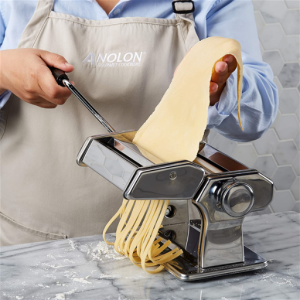
The process of determining the best manual pasta maker includes considering user reviews, build quality, ease-of-use features, and versatility.
- Marcato Atlas 150: This Italian-made chrome-plated steel machine is renowned for its durability and precision. The device has various settings that enable users to adjust dough thicknesses and shape many kinds of kinds of pasta they may need depending on their tastes.
- Imperia Pasta Maker: Also made in Italy, this brand is known for being sturdy and easy to use by consumers compared to other types available in the market today. Furthermore, this product always comes with a double cutter, which makes fettuccine and tagliatelle only, but additional attachments exist for more choices of pasta. Its simplicity and dependability have made it one of the most preferred brands.
- OxGord Stainless Steel Pasta Maker: It is a machine that is admired by its users for being cheap while achieving its purpose as expected by customers. It has thickness adjustable settings and cutting attachments of different kinds. This product is easy to use and clean, hence suitable for beginners who want to save money.
All these pasta makers perform excellently, making them among the top brands on the market today.
Features of the Marcato Atlas 150 Pasta Machine
The standout of the Marcato Atlas 150 is its high-quality construction and user-friendly nature. It has key features such as;
- Robust Construction: Long-lasting durability guaranteed by steel plating with chrome.
- Adjustable Thickness Settings: Dough thickness can be more effectively controlled at nine different settings from 0.6 to 4.8mm.
- Pasta options to suit your needs: Among others are making lasagnas, fettuccine, or tagliolini.
- Compact Design: This facilitates more accessible storage in any kitchen due to its small base size.
- Ease of Cleaning: Hygiene and maintenance are effortless since they come apart quickly for cleaning purposes.
- Optional Attachments: Other types of pasta, such as ravioli or spaghetti, can be used because they have other attachments that fit into them.
All these features make the Marcato Atlas 150 a top manual pasta maker choice for enthusiasts who want quality and versatility in their machines.
Comparing the Imperia Pasta Maker and Other Models
When comparing Imperia Pasta Maker to other leading brands, three factors emerge as most significant: build quality, ease of use, and versatility.
- Build Quality: The Imperia Pasta Maker is made of heavy-duty stainless steel and lasts a long time. The Marcato Atlas 150 is also made of highly durable chrome-plated steel, while the OxGord Stainless Steel Pasta Maker offers considerable durability at a lower price range.
- Ease of Use: The Imperia Pasta Maker is designed for smooth operation, which makes it easy to work around while creating pasta dishes. In addition, the Marcato Atlas 150 boasts ease of use through its adjustable thickness settings that follow logic and disassembly aspects for cleaning purposes. However, OxGord seems rougher, but beginners will still find it quite user-friendly.
- Versatility: The Imperia Pasta Maker’s multiple attachment options enable you to experiment with various recipes. Nevertheless, thanks to a wider range of possible additional accessories available on the market, this feature distinguishes Marcato Atlas 150 from other pasta makers. The OxGord Stainless Steel Pasta Maker offers other cutting attachments, though not as many options as the Marcato.
To sum up, when it comes to build quality, ease of use, and versatility, the Imperia Pasta Maker is closely matched by the Marcato Atlas 150. However, its wider variety of attachments makes it more flexible for pasta enthusiasts. Conversely, the OxGord model can be a decent pick for beginners, mainly due to budget constraints.
The Pasta Master: A Guide to Find the Best
When looking for the best pasta maker, many factors have to be considered, such as quality of construction, how easy it is to use, and versatility. The Marcato Atlas 150 is a favorite for most people because of its high-quality build, easy user interface, attachments, and ability to make different types of pasta. The Imperia Pasta Maker comes second after Marcato, with people appreciating it more due to its durability and simplicity, besides having fewer attachment choices than those of Marcato. The third option is OxGord Stainless Steel Pasta Maker, which is quite affordable, has fair enough functionality and is primarily suitable for beginners. At the end of it all, one’s choice depends on his or her personal needs and budget, but often, the name “Marcato Atlas 150” comes up as the number one option.
How to Make Pasta with a Hand Crank Pasta Machine
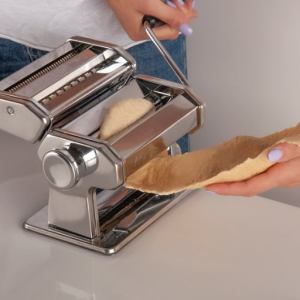
Before initiating the preparation of dough, you should be ready with all the necessary ingredients. Mix flour and eggs in a large bowl until it forms into lumpy dough. Knead the dough until smooth on a floured board, then elasticize it, leaving it to relax for approximately 30 minutes. Get several smaller pieces by dividing your dough and rolling them flat between your palms. At first, pass each piece through the machine’s rollers at the widest setting, reducing them accordingly until one attains the desired level of thickness. The next step is to slice these sheets into desired pasta shapes using its cutting attachment once they are all set up for rolling out the dough. Ultimately, cook your fresh pasta in boiling water until the preferred texture has been reached, then serve with your favorite sauce.
Preparing the Pasta Dough
To prepare pasta dough, start using high-quality flour such as “00” flour or semolina flour, giving homemade pasta a desirable texture. You will require 2 cups of flour and three large eggs to make plain pasta dough. A mound made from flour can be built up on a clean working surface with a hole located centrally. Break the eggs into this well, then gently whisk them with a fork. Slowly pull portions of the walls of the well down towards the egg mix so that you gradually form a soft wheat–egg paste. Once not so sticky, add some water so that it becomes elastic enough to make you do something for around ten minutes, kneading it with hands only. Should dry, one small amount of water needs to be added; however, if wet, more dust sprinkles may be put on as required.? Place it covered in plastic wrap and let it sit at room temperature for half an hour before rolling it out upon hand-crank machines to make pasta again.
Using the Pasta Roller and Cutter
First, ensure your pasta roller is firmly attached to your countertop or working area. Use the broadest setting on the rollers as a starting point. At first, flatten a little of your rested dough with your hands. While rotating the crank, feed it through the rollers. Fold this dough into thirds, rotate it 90 degrees, and put it back again. Repeat this procedure several times to achieve a uniform texture.
We can slowly achieve the desired thicknesses by bypassing each sheet only once through each narrowing roller setting. This adjustment usually helps us finish with thin yet workable dough. After that, place the dough on a floured surface.
Then, attach a cutting accessory to your machine. Pass each sheet of dough through the cutter so as to form pasta shapes like spaghetti, fettuccine, or tagliatelle, among others that you desire. Dust a little flour over cut pasta to avoid sticking, and let it dry slightly before cooking it down. When you are set for this cook fresh pasta in salted boiling water within just minutes than dried one does; Remember that fresh noddles take less time than those prepared from dry ingredients; hence they should not be overcooked like their counterparts. In conclusion, serve them with any sauce you like best, and there will be no regret for having enjoyed yourself today.
Drying and Storing Homemade Pasta
The drying of homemade pasta is crucial in order to retain its shape and texture. For flat pasta like fettuccine or tagliatelle, lay the cut pasta on a clean towel or floured baking sheet on one level. However, for long noodles like spaghetti, you can hang it over a rack for drying pasta or even on a neat broomstick perched between two chairs. Moreover, leave it to dry for at least thirty minutes until it is no longer sticky.
To store the dried pasta, you can put it in an air-tight container or zip-top bag. Write the date and kind of pasta on the container. This air-dried homemade pasta may last up to two weeks at room temperature in a cool, dry place. If needed for long-term storage, freeze instead of refrigerating. Spread out dry shells onto a baking tray and freeze till firm. After that, put frozen shells into freezer-safe containers or bags. These frozen shells could be kept for up to 3 months and cooked right from a frozen state.
What Are the Benefits of a Hand Crank Pasta Maker?
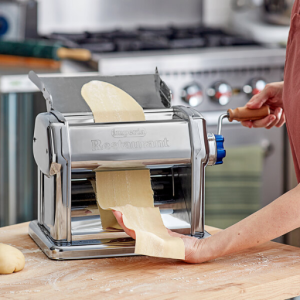
Manual pasta machines have several advantages for home cooks. First, they allow you to adjust the thickness and texture of your pasta according to your liking. Second, they are generally cheaper and more durable than electric ones. Furthermore, a manual pasta maker does not need electricity, making it an eco-friendly and convenient tool for all those who enjoy making pasta in any venue. Lastly, rolling and cutting by hand can be a deeply satisfying form of cooking that adds traditional craftsmanship to your culinary skills.
Why Choose a Manual Pasta Maker Over an Electric Pasta Maker?
When deciding between a manual pasta machine or an electric one, one needs to consider several considerations. To begin with, manual pasta makers are generally more affordable than their electrical alternatives, thus providing value for money for homemade pasta enthusiasts. Similarly, they are known for their simplicity and durability as they require little maintenance while lasting many years if well taken care of. Manual pasta makers allow you more control over how dense or smooth you want your paste, enabling you to achieve the desired consistency easily compared to electric models, which mostly rely on electricity; this can be advantageous, especially in places with no power supply. Also, using a manual pasta maker may be immersive and enjoyable because it lets you participate more actively in this traditional art of making pasta. If you prefer hands-on craftsmanship or something more personal, go with a manual pasta maker.
Enjoying Fresh Pasta at Home
Few things are as satisfying and delicious as making fresh pasta at home. Most preferred sources indicate that homemade pasta tastes better than what you buy from the grocery store, giving you a chance to have your favorite ingredients. More decadent and more authentic flavors can be achieved by using high-quality flour and fresh eggs. Creating pasta from scratch is simple: mix the dough ingredients, knead them until smooth, let them rest, and then roll them out with a manual pasta maker. After achieving the desired thickness, cut it into different shapes, such as fettuccine, spaghetti, or ravioli. Fresh pasta takes considerably less time to cook, usually just a few minutes in boiling water. This results in well-cooked tender noodles with many good accompaniments like plain marinara sauce or creamy Alfredo sauce, which is known worldwide for its rich taste.
Cost Comparison: Electric Machine vs Manual Machine
When comparing electric pasta machines to manual ones, several cost-related aspects must be considered. Electric machines are said to come at relatively high prices since they have more advanced features and work automatically. Electric models average between $100 and $300, depending on the brand name and increased abilities. Their functions save time, making them worth buying when you make a lot of pasta.
On the other hand, manual machines are often priced at around $20 – $100, hence affordable for most customers who may not need sophisticated models, for example, those who live alone or don’t want to engage in lots of technicalities during the preparation process. Despite having lower costs than electrical devices, these appliances require much effort plus additional time that some people may find inconvenient, but they usually serve long enough; thus, these types are considered more reliable by old-school Italian families.
In brief terms, if your main concern is speed along with saving time, it is better to choose an electric pasta machine given your budget. On the other hand, if you prefer to have more control over the preparation process and save on costs, then you should consider a manual pasta maker.
Where to Buy a Pasta Maker?

Various locations, both online and in brick-and-mortar stores, have pasta-making machines available for purchase. They include major online retailers such as Amazon, Walmart, and Bed Bath and Beyond, where you can find a wide range of electric and manual pasta machines; many have customer reviews to help you choose one. Besides that, specialist kitchen shops like Williams-Sonoma and Sur La Table carry high-quality preparation materials. Moreover, local department stores and kitchenware shops also tend to stock these items for those who prefer to see what they purchase before paying.
Top Places to Purchase a Pasta Maker Machine
- Amazon: One of the main reasons to buy a pasta maker from Amazon is its vast variety of options at competitive prices. It offers several brands and models so customers can gain insight from other users’ feedback. Furthermore, Amazon is known to provide prompt delivery services and remarkable customer care support, which makes it an ideal choice for most online shoppers.
- Williams-Sonoma: Williams-Sonoma is widely regarded as a reliable source of kitchen equipment, including pasta makers. It has a well-structured collection of high-end pasta-making machines suited to people who love cooking and want long-lasting appliances that work perfectly. Those keen on having a personal shopping experience should visit Williams-Sonoma, where they will find staff who understand everything about the products being sold.
-
Sur La Table: You can also get excellent pasta makers at the Sur la Table, which stocks varied models from different companies emphasizing quality performance. Shoppers can try out some products before purchasing to pick the best machine according to their particular needs through guidance from trained professionals, among others found in-store, while those buying online benefit from a more comprehensive selection and convenient shipping alternatives available online.
Considerations for Buying a Pasta Maker Online
When you want to buy a pasta-making machine online, various aspects should guide your selection:
- Reviews and Ratings: Check the reviews and ratings of different models given by consumers, as this will help you determine their performance, durability, and ease of use. Amazon’s website, for instance, has an array of customers’ opinions that may direct you to what to settle for.
- Price and Value: Prices can differ between brands or models. You can evaluate prices from websites like Williams-Sonoma, Sur La Table, and Amazon, among others, to get value for money.
- Features and Specifications: Ensure it is adjustable and easy to clean, whether manual or electric. Product descriptions in online stores usually give detailed information about these features.
- Shipping and Returns: Confirm the cost of delivery services, the duration before delivery, and the return policy. This could influence your choice since Amazon offers quick shipping services and convenient means for returning unwanted products.
- Warranty and Customer Support: Go for items with warranty coverage plus reliable customer support. It also ensures that their agents will cater to any malfunctions upon purchase. On the other hand, Williams-Sonoma boasts of informed attendants who are always friendly, hence their good customer relations.
Considering these factors, you can make a well-informed decision and choose a pasta maker that best suits your culinary needs and preferences.
Tips for Choosing the Best Pasta Makers from Retailers
When selecting a pasta maker, considering recommendations from reputable websites can be invaluable. Here are some concise tips to guide your decision:
- Ease of Use: Choose a pasta maker that is easy to assemble and operate. Features such as clear instructions and intuitive design can significantly enhance your experience.
- Cleaning and Maintenance: Choose a model that is straightforward to clean. Removable parts and dishwasher-safe components are highly recommended.
- Versatility: Consider a pasta maker that offers multiple pasta shapes and thickness settings. This feature provides versatility, allowing you to make various types of pasta.
- Durability: Look for materials such as stainless steel, which ensure longevity and durability. A robust build quality will withstand frequent use.
- Customer Feedback: Always consider models with high customer ratings and positive reviews. These testimonials can give insight into the product’s real-world performance and reliability.
Focusing on these tips will better equip you to choose a pasta maker that perfectly complements your culinary adventures.
Frequently Asked Questions (FAQs)
Q: What are the benefits of using a hand crank pasta maker over an electric pasta machine?
A: Hand-crank pasta makers provide a more authentic and traditional pasta-making experience. They offer greater control over the thickness setting of your pasta sheets and are generally easier to use and maintain. Manual pasta machines are also less expensive and do not require electricity, making them a more sustainable option.
Q: Which are the best hand-crank pasta makers of 2024?
A: Some of the best pasta makers of 2024 include the CucinaPro Pasta Maker Deluxe, the OxGord Pasta Maker, and various models from Marcato. These pasta makers are highly rated for their durability, ease of use, and ability to produce high-quality pasta sheets with consistent thickness settings.
Q: How does the Kitchenaid Pasta Roller compare to a traditional hand-crank pasta maker?
A: The Kitchenaid Pasta Roller is a pasta maker attachment designed for the Kitchenaid Stand Mixer. It offers the convenience of an electric machine while maintaining the quality of a hand crank pasta maker. It allows for multiple thickness settings and makes rolling out pasta sheets very easy, though it requires owning a Kitchenaid Stand Mixer.
Q: Can you attach a pasta cutter to a hand-crank pasta maker?
A: Yes, many hand-crank pasta makers come with or have the option to attach a pasta cutter. This attachment helps quickly cut the pasta sheets into various shapes, such as fettuccine, spaghetti, and more. It’s a valuable addition for those looking to make different types of pasta.
Q: How do I maintain and clean my hand-crank pasta maker?
A: Maintaining and cleaning a hand-crank pasta maker is simple. After use, let any remaining dough dry, then brush it off with a soft cloth or brush. Avoid using water as it can cause rust. For a more thorough cleaning, you can disassemble some parts and clean them individually. Regular maintenance ensures the longevity and functionality of the pasta maker.
Q: What are the advantages of using a pasta drying rack?
A: A pasta drying rack helps dry out freshly made pasta, preventing sticking and even drying. This process is essential when making pasta at home, as it helps achieve the right texture. Dry pasta is more straightforward to store and cooks more consistently. A pasta drying rack is handy for long pasta shapes like spaghetti and fettuccine.
Q: Are there specific pasta recipes suitable for hand crank pasta makers?
A: Hand-crank pasta makers are versatile and can handle various pasta recipes. Typical recipes include basic egg pasta, spinach pasta, and even whole wheat pasta. The pasta maker allows experimenting with different ingredients and flavors to create unique types of pasta. Making fresh pasta at home can also be a fun and satisfying culinary adventure.












